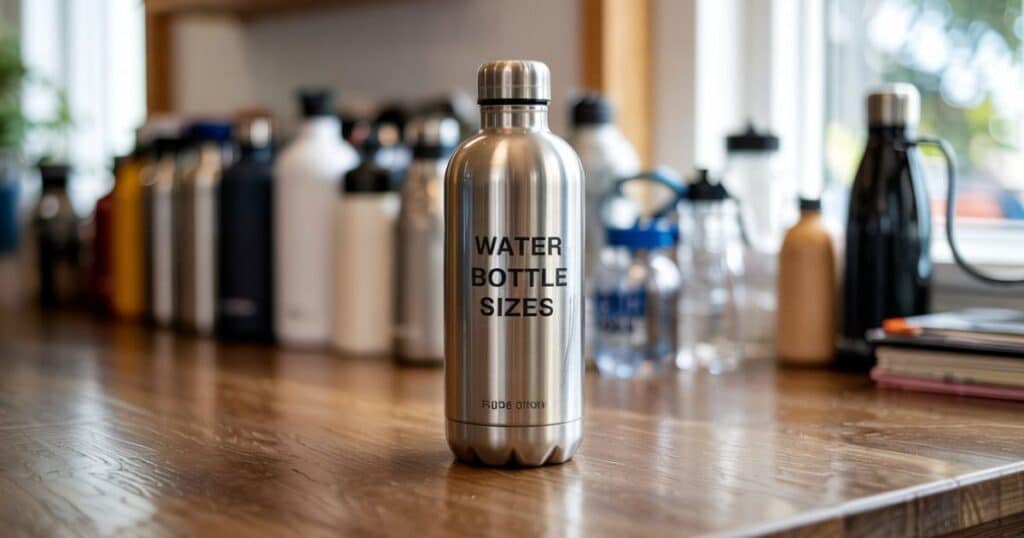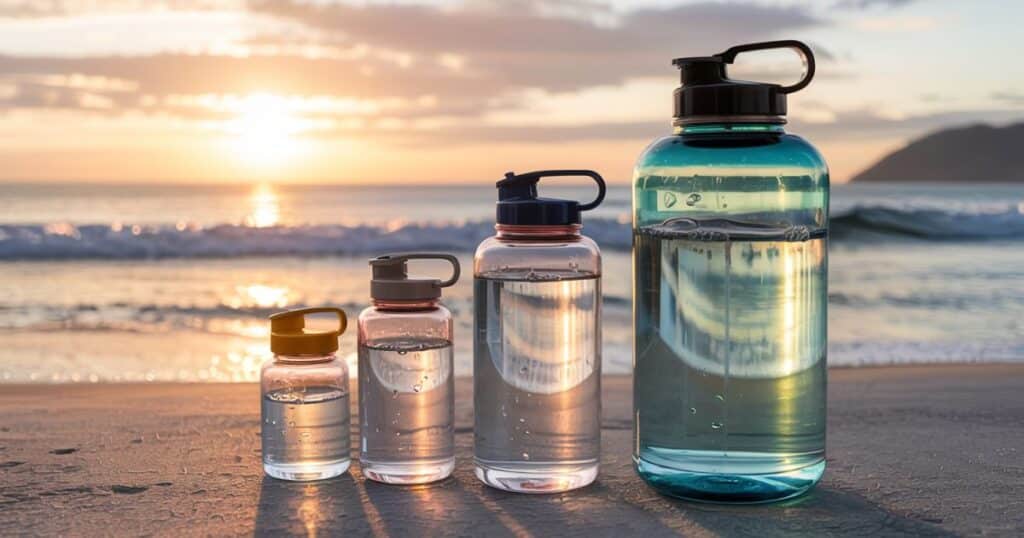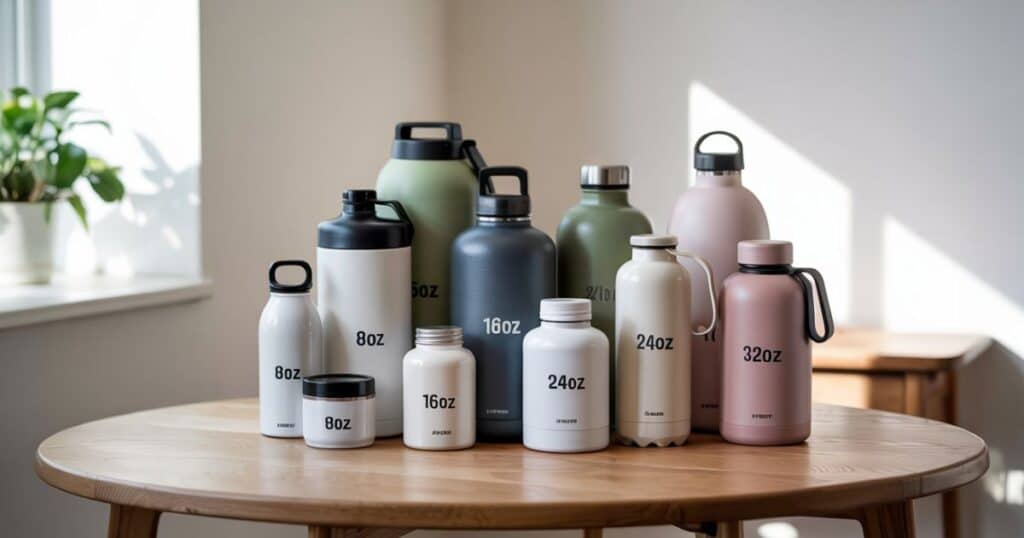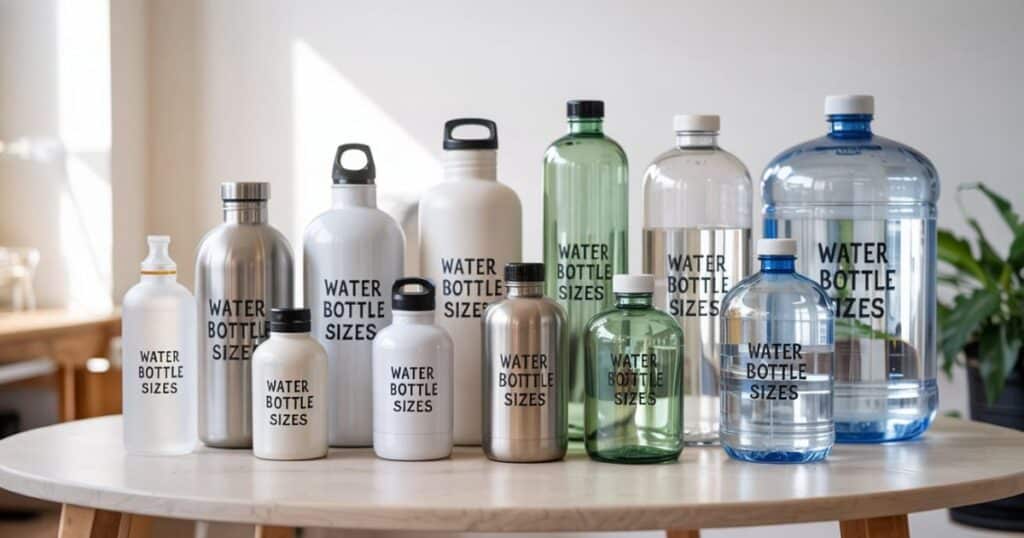Ever found yourself staring at a wall of water bottles, wondering which size would best fit your lifestyle? You’re not alone. From gym-goers to hikers, office workers to students, we all need hydration on the go but choosing the right bottle size can make a huge difference in your daily routine.
Water bottles come in a dizzying array of sizes, each designed for specific needs and activities. The right size can mean the difference between staying perfectly hydrated or running dry when you need water most.
In this guide, we’ll dive into everything you need to know about water bottle sizes, from pocket-sized options to massive jugs. I’ll help you understand which size works best for different activities, how to measure capacity accurately, and even share some surprising facts along the way.
How to Understand Water Bottle Sizes
Water bottles typically range from small 8-ounce containers to massive 128-ounce (1-gallon) jugs. Most everyday bottles fall somewhere between 16 and 32 ounces about 2-4 cups of water.
These measurements typically refer to fluid capacity rather than physical dimensions, though larger capacity naturally means a bigger bottle.
When choosing a bottle, consider where you’ll use it. A compact 16-ounce bottle might slip easily into a purse or car cup holder, while a 40-ounce bottle provides extended hydration for long hikes but won’t fit standard holders.
Standard Water Bottle Sizes
8-10 Ounce Bottles
These measurements typically refer to fluid capacity rather than physical dimensions, though larger capacity naturally means a bigger bottle.
The smallest standard water bottles typically hold 8-10 ounces (about 240-300 ml) of liquid. While these might seem tiny compared to other options, they serve important purposes in several contexts.
These compact bottles fit perfectly in children’s lunch boxes and small bags. Their lightweight design makes them ideal for young kids who might struggle with heavier bottles. The size also helps with portion control perfect for parents monitoring their children’s beverage intake during school hours.
Many high-end reusable water bottles offer this size as their travel or “mini” option. These bottles often feature the same premium materials and design as their larger counterparts but in a more portable package. They’re perfect for short outings where you don’t want to be weighed down.
Interesting Fact: The aviation industry loves these smaller bottles they’re typically the size served on airplanes because they fit perfectly on meal trays and minimize weight, which helps reduce fuel consumption during flights.
12-16 Ounce Bottles (350-500 ml)
Perhaps the most common size you’ll encounter, 12-16 ounce bottles represent the sweet spot between portability and adequate hydration for short periods.
These bottles provide enough water for a typical workout session or office meeting without becoming cumbersome. Many disposable water bottles fall into this range, as do coffee shop tumblers and standard reusable bottles. They fit comfortably in most car cup holders, bicycle cages, and backpack side pockets.
For caffeine lovers, this size aligns perfectly with standard coffee servings a medium coffee shop drink typically holds 16 ounces. This compatibility makes these bottles excellent for those who alternate between water and coffee throughout the day.
Interesting Fact: The 16.9-ounce (500 ml) bottle became standardized globally largely because it offers about the right amount of water to take with medication enough to properly dissolve pills and help them travel through the digestive system, according to pharmacists.

20-24 Ounce Bottles (600-700 ml)
Moving up in size, 20-24 ounce bottles provide extended hydration without excessive bulk, making them popular among active professionals and fitness enthusiasts.
This size holds enough water to keep you hydrated through a moderate workout or half-day office session without refilling. It represents about one-third of the daily water intake recommended by many nutritionists (assuming the standard eight 8-ounce glasses recommendation).
Many sports and specialty bottles fall into this category, including most mainstream Hydro Flask, S’well, and CamelBak designs. These bottles typically maintain a diameter slim enough for cup holders while extending their height to increase capacity.
Interesting Fact: Studies show that people with 20+ ounce water bottles visible on their desks consume nearly 50% more water throughout the day than those without visible reminders to drink, making this size particularly effective for improving hydration habits at work.
See Also: Milk Carton Sizes: Everything You Need to Know
32 Ounce (1 Liter) Bottles
The 32-ounce or 1-liter bottle represents an important milestone in the water bottle universe large enough for extended use but still manageable for everyday carry.
These bottles hold enough water to satisfy half your daily hydration needs in one filling. Their substantial size makes them excellent companions for desk workers who don’t want frequent refill trips, gym-goers planning longer workouts, or anyone spending a full day away from reliable water sources.
Most premium water bottle brands offer their flagship models in this size, often with enhanced insulation that can keep beverages cold for 24+ hours or hot for 12+ hours. The trade-off comes in weight and bulk these bottles typically weigh 1-2 pounds when full and won’t fit in smaller bags or standard cup holders.
Interesting Fact: The rise in popularity of 32-ounce bottles correlates directly with increasing awareness of proper hydration levels. Sales of bottles this size have increased over 300% in the last decade as health experts have emphasized drinking more water throughout the day.
40-50 Ounce Bottles (1.2-1.5 Liters)
When serious hydration becomes necessary, many people turn to 40-50 ounce bottles, which balance substantial capacity with reasonable portability.
These larger bottles can easily sustain you through intense outdoor activities, long workdays, or extended travel. They typically feature reinforced carrying handles, wide mouths for easy filling with ice, and durable construction to withstand inevitable bumps and drops.
The ergonomics of these bottles receive special attention from manufacturers, with thoughtfully designed grips and proportions that distribute weight effectively. Many include measurement markings to help track intake throughout the day.
Interesting Fact: Some 40-ounce bottles were originally designed following consultations with emergency preparedness experts, who calculated this size as the minimum daily water requirement for an adult in a disaster scenario.
64 Ounce (Half-Gallon) Bottles
At 64 ounces, water bottles enter serious territory large enough to meet most people’s entire daily hydration needs in a single fill.
These substantial vessels have gained tremendous popularity among fitness enthusiasts who use them to ensure adequate hydration during long training sessions. They’re also favored by outdoor workers, construction crews, and anyone spending extended periods in environments without easy access to water fountains.
The half-gallon size creates new design challenges, which manufacturers address through reinforced handles, dual-opening systems (one for drinking, one for filling), and sometimes even shoulder straps for easier transport.
Interesting Fact: Many personal trainers now specifically recommend half-gallon water bottles to clients because studies show that approximately 75% of Americans suffer from chronic mild dehydration and visible measurement markings on these larger bottles help people visually track their progress toward proper hydration goals.
128 Ounce (One-Gallon) Jugs
At the upper end of the spectrum, gallon water bottles make a clear statement about serious hydration commitment.
Originally popularized by bodybuilders and extreme athletes, gallon jugs have crossed into mainstream use, particularly among those pursuing fitness goals or working in physically demanding environments. Their massive capacity eliminates the need for refills throughout even the longest days.
These behemoths typically feature substantial handles, reinforced walls to prevent breakage under their own weight when full, and sometimes even wheels or carrying straps to assist with transportation. Many include motivational time markers to encourage consistent drinking throughout the day.
Interesting Fact: The “gallon challenge” trend that swept through fitness communities helped popularize these oversized bottles. While drinking a full gallon daily isn’t necessary for most people, the visibility of these large containers has measurably increased average water consumption among users compared to those using smaller bottles.

Special-Purpose Water Bottle Sizes
Collapsible Bottles (Variable Sizes)
Collapsible water bottles represent an innovative solution to the bulk problem, starting small but expanding to hold significant amounts of water when needed.
These bottles typically compress to just 1-2 inches thick when empty but expand to hold 16-32 ounces when filled. This versatility makes them particularly valuable for travelers, hikers with limited pack space, or commuters who need water during the day but don’t want a bulky empty bottle on the return trip.
The materials used must balance durability with flexibility, leading to specialized silicone, BPA-free plastics, or hybrid designs that incorporate rigid components for drinking alongside collapsible storage sections.
Interesting Fact: The technology behind many collapsible water bottles was adapted from specialized containers originally developed for military operations, where weight and space efficiency can be mission-critical factors.
Hydration Reservoirs (1-3 Liters)
Moving beyond traditional bottles, hydration reservoirs or “bladders” offer an entirely different approach to portable water storage.
These flexible pouches typically hold between 1-3 liters (32-100 ounces) and are designed to fit inside specialized backpacks or carrier systems. A long tube extends from the reservoir to a bite valve, allowing hands-free drinking during activities like hiking, cycling, or skiing.
The design emphasizes low profile and weight distribution rather than insulation or durability. The water conforms to your back rather than maintaining a rigid shape, making it more comfortable during active pursuits.
Interesting Fact: Hydration reservoirs were revolutionized by a mountain biker who, frustrated with reaching for water bottles during races, created the first CamelBak by sewing an IV bag into a sock and running a tube over his shoulder a makeshift solution that evolved into a multi-million dollar industry standard.
See Also: Chip Bag Sizes – Sizes of Common Objects and Stuff
How to Choose the Right Water Bottle Size
Selecting the perfect water bottle size depends on carefully balancing several factors:
Consider Your Daily Activities
- Office Workers: A 20-32 ounce bottle usually provides enough water between reasonable refill opportunities while still fitting in bags and on desks.
- Fitness Enthusiasts: 32-64 ounce bottles minimize disruptions during longer workouts.
- Outdoor Adventurers: Consider 32+ ounce bottles or hydration reservoirs based on water availability during your activities.
- Commuters: 16-20 ounce bottles offer good hydration without excessive weight or bulk on public transit.
Think About Practical Limitations
- Cup Holders: Most standard car cup holders accommodate bottles up to 3-3.5 inches in diameter, typically limiting you to 24 ounces or less.
- Backpack Side Pockets: Check the depth and elasticity many accommodate up to 32 ounces, but larger bottles may protrude precariously.
- Weight Considerations: A full gallon of water weighs approximately 8.3 pounds significant when carried over time.
Environmental Factors
- Hot Weather Activities: Increase your bottle size by at least 30% when exercising in heat to account for additional water loss.
- Air Travel: Remember that empty bottles can pass through security and be filled afterward, saving you from purchasing overpriced airport water.
Practical Measurement Tips
Need to estimate water bottle capacity without markings? Here are some helpful guidelines:
- Your cupped hands together hold approximately 2-3 ounces of water.
- A standard shot glass holds 1.5 ounces.
- A tennis ball container would hold about 12 ounces of water.
- A standard coffee mug typically holds 8-12 ounces.
When filling unmarked bottles, use household measuring cups or a kitchen scale (remembering that one ounce of water weighs approximately one ounce).

The Future of Water Bottle Sizes
The water bottle market continues to evolve, with several interesting trends emerging:
- Smart Bottles: Integrated technology now tracks water consumption and syncs with fitness apps, typically in 20-24 ounce models.
- Sustainable Sizing: Manufacturers increasingly design bottles specifically sized to replace the exact number of disposable bottles consumers might otherwise use.
- Activity-Specific Engineering: Rather than one-size-fits-all approaches, companies now create precisely sized bottles for specific activities like yoga (smaller), marathon running (medium with specialized grips), or hiking (larger with filtration).
Conclusion: Finding Your Perfect Fit
The ideal water bottle size isn’t just about capacity it’s about finding what integrates seamlessly into your lifestyle. A bottle that’s too small leads to chronic dehydration; one that’s too large becomes a burden left behind.
Consider tracking your typical daily water consumption for a week to determine your actual needs. Experiment with different sizes before investing in premium bottles. Many hydration experts suggest owning multiple sizes for different activities rather than trying to find one perfect all-purpose bottle.
Look around your home and count how many different water bottle sizes you already own you might be surprised at the variety! The perfect bottle combines adequate capacity for your specific needs with the convenience that ensures you’ll actually use it consistently.
Remember that the best water bottle is ultimately the one that helps you stay properly hydrated throughout your day regardless of its size.
Read more knowledgeable blogs on Measure Take.



